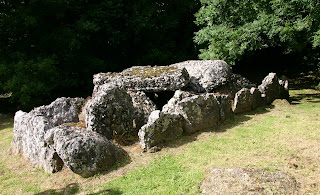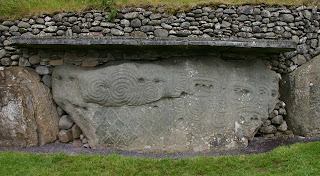
Thursday, July 31, 2008
Still not a food blogger

Friday, July 25, 2008
I'm not a cooking blog


For starter we had a mixed salad with wonderful fresh and organic bread:

Pop goes the dinner

Organic pasta, fennel, carrots, and red bell pepper. The base for the sauce was purée from red bell pepper (Paprikamark) which made an incredibly tasty background for the pasta. You can add cheese if want to stock up your proteins.
Thursday, July 10, 2008
Last Days in Dublin

On the way I found a cool 'Viking' boat, ehhm...ship.

The rest of the day I spent on the shopping streets, but I had a wonderful lunch at the all-vegetarian little restaurant, the Cornucopia Wicklow Street. After all the overcooked vegetables during our excursion, it was a real wellcome change (I was the only vegetarian in our group).
 Now that I have bought more than 10 kg of books I thought no more books anymore and therefore today I went to Trinity college, to see the book of Kells, a manuscript from around AD 800. A hefty price of 7 Euros for students for a small exhibition of a couple of medieval manuscripts but a beautifully made exhibtion, that I have to admit.
Now that I have bought more than 10 kg of books I thought no more books anymore and therefore today I went to Trinity college, to see the book of Kells, a manuscript from around AD 800. A hefty price of 7 Euros for students for a small exhibition of a couple of medieval manuscripts but a beautifully made exhibtion, that I have to admit.

And this is all for Dublin because now I am sitting at the airport and thanks to free i-net (thanks to eircom) I wirte my last post of my trip to Ireland. From now on it will be all boring stuff again :)
And a last tribute to my favourite cider:

Tuesday, July 08, 2008
Dublin on my own


I spent the rest of the morning and the early afternoon in the National Museum of Dublin. Unfortunately you can't take photographs. Which is a sad thing, since it hosts wonderful artefacts. Here are just some appetizers:
the macehead from the passagetomb of Knowth:

the Tara brooch:
 Arnold 1977
Arnold 1977
The shield from Lough Gur:

and many other splendid things, gold lunulae, decorated stones, high crosses, Egyptian artefacts, Cypriotic vases, and, and, and...
After a short break at the museum's café and nut-and-lentil roast I was energized enough to have a look at the Chhrist Church Cathedral; It was originally begun to be built in 1038 by King Sithric Silkenbeard, the Danish Viking King of Dublinthis. Howeer it was intensively remodelled and renovated, especially from the 16th century onwards and so hardly any original details remained. This is a view of the bell tower:

The stained windows in the Cathedral (Patrick is wearing pink :)) )

The beautiful floor tiles:

And the 'Enterprise' in the crypt:

I finished the day with 'The Weir' at the Gate Theatre:

From their webpage (http://www.gate-theatre.ie/prog.html)
The Weir, by acclaimed playwright Conor McPherson, premiered at the Gate in 1998 to critical and successful acclaim. This atmospheric tour de force, set in present day rural Ireland, finds Valerie, on arriving at a small country bar, spellbound by an evening of ghostly stories from the local bachelors. Their tales, both funny and chilling, are a mesmerising mixture of rumour and local legend. However, much to their surprise, she has her own story to tell…
Monday, July 07, 2008
Roscrea
 The round tower is part of the complex of St. Cronin's church and was built around the 12th century:
The round tower is part of the complex of St. Cronin's church and was built around the 12th century: The high cross that belonged to the church is now situated in the former mill:
The high cross that belonged to the church is now situated in the former mill: This is a portrait from the 1720s Damer House which was built in the castle courtyard:
This is a portrait from the 1720s Damer House which was built in the castle courtyard: We then had a short drive to see the Monaincha monastery which was built on a small island. The lake was drained in the last century, so we could easily walk there. It became a famous pilgrimage site and it is still called the'holy island'. In the 10th century publication The Annals of the Four Masters it was described as the 31st Wonder of The World, though unfortunately it didn't say what the other wonders were.
We then had a short drive to see the Monaincha monastery which was built on a small island. The lake was drained in the last century, so we could easily walk there. It became a famous pilgrimage site and it is still called the'holy island'. In the 10th century publication The Annals of the Four Masters it was described as the 31st Wonder of The World, though unfortunately it didn't say what the other wonders were.
 We then went to the Cistercian Abbey Mount St. Joseph Abbey, which was founded in 1878. We had lunch there in the guest house and then a tour through the monastery and it's library:
We then went to the Cistercian Abbey Mount St. Joseph Abbey, which was founded in 1878. We had lunch there in the guest house and then a tour through the monastery and it's library:

This was the end of our WAC-6 post-congress tour and we returned safely to Dublin. So this is my last night on the UCD campus.
Sunday, July 06, 2008
The Burren




We had lunch at the wonderful and recently opened 'An Fulacht Fia' which is the name of a prehistoric cooking place. If you ever happen to be in this area don't miss the oppotunity to have lunch or dinner at this stylish restaurant...their homebaked bread is heavenly and the view (the Atlantic) is fantastic, too.
 and that is what is left of its splendid stone-wall enclosures.
and that is what is left of its splendid stone-wall enclosures.
And the best for last, a Portal Dolmen with 20 burials from 3800 to 3200 BC, called Poulnabrone.

Saturday, July 05, 2008
WAC-6 6th Day


Next stop was the partially drained Lough Gur, a horseshoe-shaped lake with loads of archaeology around it. No wonder it is such a pretty area, I would have settled there, too. Although some people probably would complain because of all the wetland insects.


This is Bouchiers castle, a five storey tower built by the Anglo-Norman in the 14th century:




It was a long but very rewarding day and we finished it off with a wonderful dinner at the Kilmurry Lodge Hotel:

Thursday, July 03, 2008
WAC-6 4th Day

The second session was about seasonality and rock art and a number of presentations were really interesting, especially one from South Central Africa that linked the depicted signs to initiation rites through ethnographical examples. There were also wacky ones that tried to link the megalithic art of Irish passage tombs to the spawning of salmon. According to Robert Hensey the motif on the lower left are fish scales of salmon. Well, it didn't convince me at the least.
 During lunch break there was a plenary session about Tara and the new M3 motorway with many supporters (the minister, a local, and the excavation contract company) but also some archaeologist and students that accused them of falsifying data, bullying people and so on. Hopefully a landscape that is so important for the history of Ireland can be saved. But since money rules the world I fear we will lose this archaeologically and historically rich landscape around the hill of Tara.
During lunch break there was a plenary session about Tara and the new M3 motorway with many supporters (the minister, a local, and the excavation contract company) but also some archaeologist and students that accused them of falsifying data, bullying people and so on. Hopefully a landscape that is so important for the history of Ireland can be saved. But since money rules the world I fear we will lose this archaeologically and historically rich landscape around the hill of Tara. Got to http://www.savetara.com/ or http://www.tarawatch.org/ for more information. And listen to what Prof. George Eogan has to say about Tara and the M3:
http://www.youtube.com/watch?v=dk_9zkgIcxo
The last session was about rock art again and this one was really crazy. A lady tried to associate Palaeolithic cave art with mentally ill people, and a Professor from Toronto tried, with the help of a numerologist, to make an alphabet out of Palaeolithic abstract signs. The best part was how a museum in Portugal tried to bring rock art and people together and the contribution from George Nash who re-studied megalithic art and found a lot of up to now not detected motifs, from simple cupmarks to wonderfully pecked feet.
In the evening was the WAC party with -not only Guiness- but also a bronze caster

and a group of musicians:

You see, it was a long day again.

